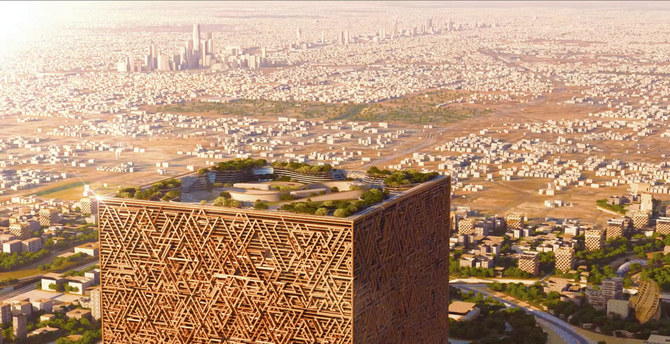
- ARAB NEWS
- 01 Aug 2025

RIYADH: Saudi Arabia is committed to “push boundaries” with its pioneering mixed-use developments, a senior executive stated.
According to Campbell Gray, CEO of AtkinsRéalis in the Middle East and Africa, the Kingdom is focusing on increasing investments in essential infrastructure projects such as water treatment plants, renewable energy initiatives, education facilities, and public transport systems.
This strategic approach is driven by the need to address the requirements of a growing population in the Kingdom.
“As we enter 2024, it is clear that Saudi Arabia will continue to innovate and push boundaries with its flagship mixed-use developments, such as NEOM and the New Murabba,” Gray told Arab News.
He added: “Also facilitating this growth is Saudi Arabia’s plans to position itself as a major supply chain hub for international companies.”
Gray referred to the Kingdom’s Global Supply Chain Resilience Initiative as an example, which aims to harness domestic resources, infrastructure, and location to attract wider investment.
“Improving its logistics efficiency is crucial to strengthening the Kingdom’s supply chain, which in turn is critical to achieving the economic diversification goals outlined in Vision 2030,” he continued.
The CEO also shed light on the role of sustainability in developments, as it will define projects in Saudi Arabia and across the wider region.
Gray emphasized the construction industry’s vital role in achieving national net-zero carbon emissions targets, stressing the need for projects to be planned, constructed, and operated efficiently and sustainably to minimize the environmental impact.

“This means finding more sustainable ways to create new supply. It also means decarbonizing existing core sectors, such as buildings, water and transport, a process that requires enhanced data analytics that allow us to run our existing infrastructure as efficiently as possible,” he stated.
Gray added: “A more developed manufacturing base would also mean investing in local capabilities, helping overcome supply chain constraints and addressing market skill gaps in advanced construction technologies.”
In December, New Murabba Development Co., a fully owned subsidiary of the Public Investment Fund, appointed AtkinsRéalis to support the design of the New Murabba masterplan, the world’s largest modern downtown in Riyadh, and the Mukaab skyscraper.
The company aims to achieve this commitment through its design principles, value engineering practices, and the integration of digital and net-zero solutions.
“Collaboration with the government, project owners and the wider supply chain is also pivotal to enhancing industry regulations and standards and ensuring we all have an active role to play in driving the sustainability agenda and socio-economic impact,” Gray said.
He added that the development’s infrastructure will be embedded with sustainable smart technology containing essential utilities and transportation services, generating car-free communities and public realms.

As we enter 2024, it is clear that Saudi Arabia will continue to innovate and push boundaries with its flagship mixed-use developments, such as NEOM and the New Murabba.
Campbell Gray, CEO of AtkinsRéalis in the Middle East and Africa
Additionally, the CEO stated the design of the New Murabba project is inspired by Riyadh’s historical harmony of nature, and it employs a data-driven approach to prioritize sustainability, user convenience, reduced reliance on transportation, walkability, and a people-centric design for public spaces.
“These extensive green spaces will also help to promote biodiversity and reduce the urban heat island effect. Meanwhile, the buildings are designed with cutting-edge energy-efficiency measures to reduce the project’s carbon footprint,” he commented.
Underlining the long-term sustainability of the New Murabba, Gray said that there is a focus on modern construction techniques and energy-efficient design.
The goal is not only to create a visually appealing environment but also to establish a sustainable community that fosters both healthy living and environmental stewardship.
“We believe that end-to-end design, engineering and project management expertise empowered by digital technologies and sustainable solutions will play a key role in supporting the construction sector growth and upskilling local talent,” Gray said.
He also stressed that Saudi Arabia “is a significant market for growing our engineering, design, project management and operations and maintenance services.”
Gray was keen to highlight Saudi Arabia’s ambitious and transformative stance through a series of megaprojects that aim to reshape the Kingdom’s landscape and the daily lives of its residents in the coming decade.
These projects include the construction of smart cities, ports, theme parks, metro lines, and the world’s tallest structure. Collectively, these initiatives, comprising more than 22 megaprojects, are envisioned to shape Saudi Arabia’s future beyond 2030.
This is evident in the recent budget for 2024, which exceeds SR1.17 trillion ($312.48 billion) and underscores the Kingdom’s resilience amidst global economic challenges, market volatility, and prevailing pessimism.
“By prioritizing increased spending on infrastructure, the budget fosters an attractive environment for investment across diverse sectors and industries,” Gray said.
Moreover, Atkins, the delivery partner for NEOM’s The Line, is adopting a highly collaborative delivery model in response to its scale, complexity, supply chain and requirements for innovation.
The development’s infrastructure will be embedded with sustainable smart technology containing essential utilities and transportation services, generating car-free communities and public realms.
“The stage is set for a new era of growth and progress in Saudi Arabia’s construction landscape,” said Gray.